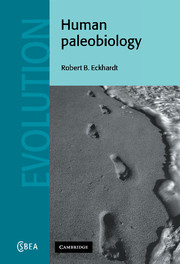Book contents
- Frontmatter
- Contents
- Preface
- Acknowledgments
- 1 Paleobiology: present perspectives on the past
- 2 Constancy and change: taxonomic uncertainty in a probabilistic world
- 3 A century of fossils
- 4 About a century of theory
- 5 Human adaptability present and past
- 6 Primate patterns of diversity and adaptation
- 7 Hominid phylogeny: morphological and molecular measures of diversity
- 8 Plio-Pleistocene hominids: the paleobiology of fragmented populations
- 9 Character state velocity in the emergence of more advanced hominids
- 10 The paleobiology of widely dispersed hominids
- 11 Paleobiological perspectives on modern human origins
- 12 A future for the past
- Bibliography
- Index
8 - Plio-Pleistocene hominids: the paleobiology of fragmented populations
Published online by Cambridge University Press: 18 December 2009
- Frontmatter
- Contents
- Preface
- Acknowledgments
- 1 Paleobiology: present perspectives on the past
- 2 Constancy and change: taxonomic uncertainty in a probabilistic world
- 3 A century of fossils
- 4 About a century of theory
- 5 Human adaptability present and past
- 6 Primate patterns of diversity and adaptation
- 7 Hominid phylogeny: morphological and molecular measures of diversity
- 8 Plio-Pleistocene hominids: the paleobiology of fragmented populations
- 9 Character state velocity in the emergence of more advanced hominids
- 10 The paleobiology of widely dispersed hominids
- 11 Paleobiological perspectives on modern human origins
- 12 A future for the past
- Bibliography
- Index
Summary
Introduction
Plio-Pleistocene hominid populations occupied a narrow genetic zone bounded by the genomes of extant chimpanzees and humans (but only approximately, because no living populations can be expected to have gene pools that have remained unchanged over millions of years). Judged from our present vantage, the outcome of hominid evolution represents a great anatomical step across this narrow genetic transition zone. The one percent DNA sequence difference between humans and chimpanzees, objectively small even now, must have been virtually indiscernible when the earliest hominid populations diverged onto their independent evolutionary pathway six to eight million years ago. At the phenotypic level, however, the evolution of hominids from ancestral apes was swift and pronounced, resulting in lasting morphological remodeling of the postcranial skeleton for upright posture and bipedal locomotion, along with other changes in cranial and dental characters.
Evolutionarily, these morphological changes establish that the adaptive capacities of early hominid populations were challenged and their gene pools restructured. Given the known extent of decoupling between molecular and morphological levels, it is probable that the first several million years of hominid evolution were characterized by discrepancies between phenostructure and zygostructure similar to those shown by the papionine populations spread across similar terrestrial ecosystems today. From the standpoint of adaptability, there is every reason to believe that in meeting these challenges, early hominids utilized capacities for flexible responses at several levels (behavioral, physiological, developmental, genetic) that we know are relied upon not only by humans, but also by papionines and to an even greater extent by chimpanzees, whose cultural capacities are increasingly well documented.
- Type
- Chapter
- Information
- Human Paleobiology , pp. 166 - 207Publisher: Cambridge University PressPrint publication year: 2000



